With the Moterra Neo Carbon 1, Cannondale want to offer the ultimate all-rounder and appeal to everyone from beginners to seasoned trail veterans. Can it deliver consistent performance in all situations, from long tours to everyday rides, all the way to challenging trail sessions? Or do you have to accept some compromises on the trail?
For an overview of the test fleet head to the group test: The best eMTB of 2021 – 25 models in review
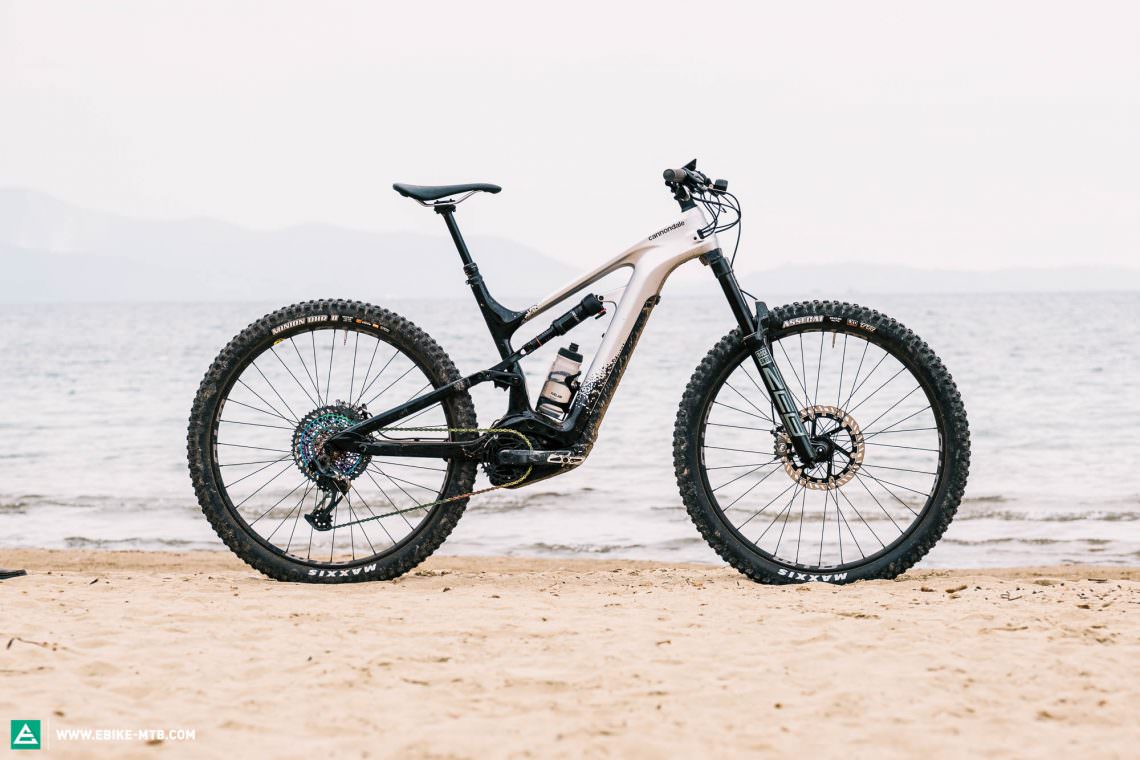
24.06 kg in size L | € 8,799 | Manufacturer’s website
While the frame platform of the Moterra Neo Carbon 1 remains unchanged from last year, the 2021 version of Cannondale’s flagship model features brand new suspension and an elegant silver-black finish. For the drive unit, the American brand relies on the proven Bosch Performance Line CX motor with a 625 Wh PowerTube, both neatly integrated into the downtube. Cannondale round off the harmonious package with a revised charger port cover, a speed sensor neatly integrated into the dropout and a huge skid plate that protects the motor from impacts. While the Kiox display, unfortunately, remains in the same exposed position on the stem, right below the display there’s now a headlight, which is an awesome and very practical feature for night rides and late commutes.
The spec of the Cannondale Moterra Neo Carbon 1: A compromise.
Das 8.499 € teure Topmodell Cannondale Moterra Neo Carbon 1 setzt für 2021 auf ein RockShox-Fahrwerk mit 160 mm, der steifen ZEB Ultimate-Federgabel und dem Deluxe Select+ Dämpfer ohne Ausgleichsbehälter. Es bietet ein einfaches Setup und einen guten Kompromiss für Anfänger und sportive E-Mountainbiker. Gestoppt wird das 24,06 kg schwere Bike von einer standfesten MAGURA MT7 mit 220-mm-Scheiben vorne und 200 mm hinten. Bei ihr hat Cannondale bewusst auf die Shiftmix-Klemmen verzichtet, um eine bessere Ergonomie im Cockpit zu gewährleisten.
The 2021 Moterra Neo Carbon 1 top-of-the-range model retails at € 8,499 and features RockShox suspension with a super-stiff ZEB Ultimate fork and a Deluxe Select+ shock without a piggyback reservoir – both control 160 mm travel. Thanks to functional and user-friendly components, the bike is easy to set up and offers a great compromise catering to both beginners and sporty eMTBers. Our test bike weighs in at 24.06 kg and is stopped by powerful MAGURA MT7 brakes with 220/200 mm rotors. In order to ensure better cockpit ergonomics, Cannondale have avoided the Shiftmix clamps we’ve had problems with on other bikes. Nonetheless, there’s still room for improvement.
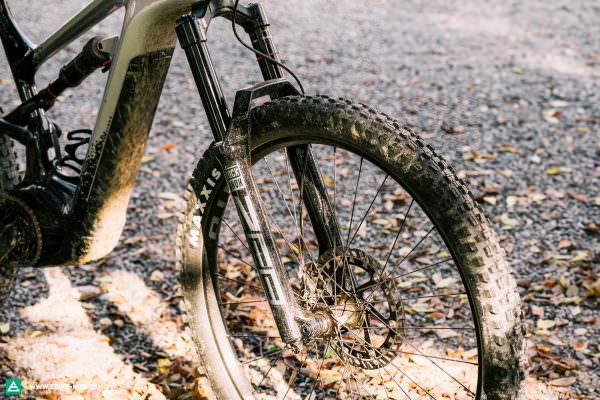
While the RockShox ZEB is an awesome upgrade compared to last year’s model, the non-piggyback shock tends to heat up too easily on long descents.
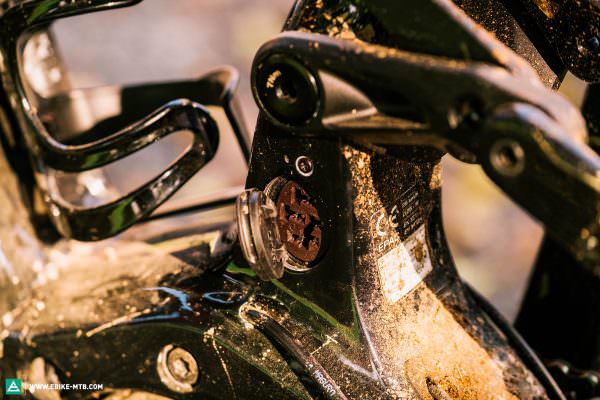
Cannondale have replaced the flimsy charger port cover of the previous Moterra with a new, more robust and flexible rubber item.
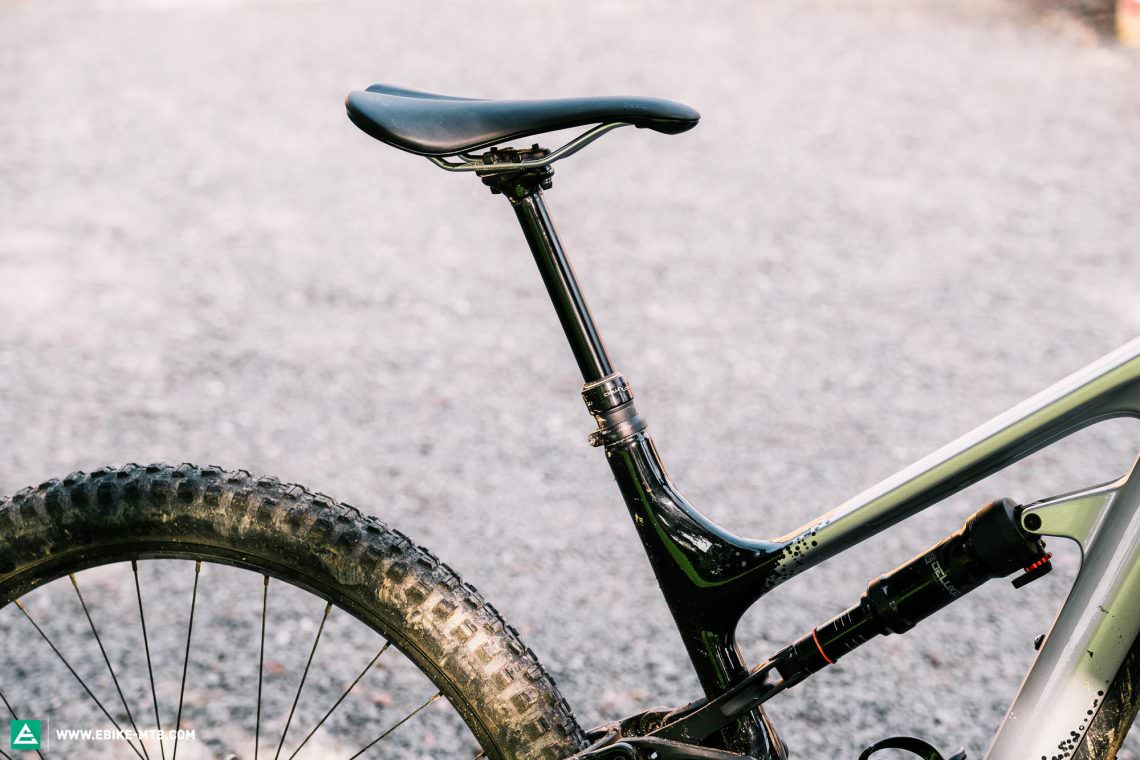
Cannondale’s in-house DownLow dropper post comes with either 125 mm (M) or 150 mm (L & XL) travel, which isn’t enough for trail riding. On top of that, the dropper remote is a wobbly ergonomics disaster. We recommend upgrading to a more robust remote.
Cannondale Moterra Neo Carbon 1
€ 8,799
Specifications
Motor Bosch Performance Line CX 85 Nm
Battery Bosch PowerTube 625 Wh
Display Bosch Kiox
Fork RockShox ZEB Ultimate 160 mm
Rear Shock RockShox Deluxe Select+ 160 mm
Seatpost Cannondale DownLow Dropper 100–150 mm
Brakes MAGURA MT7 220/200 mm
Drivetrain SRAM GX/X01 Eagle 1x12
Stem Cannondale 1 50 mm
Handlebar Cannondale 3 Riser 780 mm
Wheelset WTB KOM Trail i30 TCS 29"
Tires MAXXIS ASSEGAI EXO/Minion DHRII EXO+ 2.6"
Technical Data
Size S M L XL
Weight 24.06 kg
Perm. total weight 150 kg
Max. payload (rider/equipment) 125 kg
Trailer approval No
Kickstand mount No
Specific Features
Supernova MINI 2 PRO light with high beam

The Moterra comes with an excellent Supernova Mini Pro 2 light as standard – the best light in the test. Unfortunately, as soon as the trail gets rough, the magnetic high beam switch flies out of its holder.
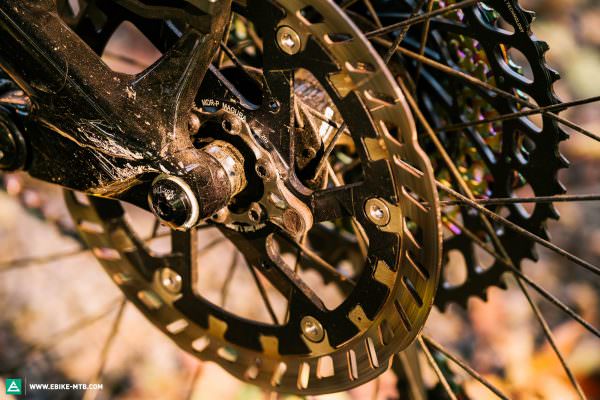
/Despite the Bosch motor, the speed sensor is safely integrated into the dropout and the magnet attached directly to the rotor, where it can’t get lost or damaged. Great!
Unfortunately, the remote of the dropper post is small, fiddly and very hard to position within easy reach. If that wasn’t enough, the dropper has only a meagre 150 mm travel. While the Supernova Mini 2 Pro light with its built-in high beam offers unrivalled performance in this group test, the additional cables and fiddly magnetic thumb switch, which is unsuited to rough terrain, clutter the cockpit. A mixed 12-speed SRAM drivetrain with GX and X01 Eagle components and the massive 10–52 t cassette provide a huge 520% gear range, while a 2.6” MAXXIS ASSEGAI EXO tire at the front and Minion DHRII EXO+ at the rear ensure sufficient traction but offer only moderate puncture protection for aggressive riders.
| Site | S | M | L | XL |
|---|---|---|---|---|
| Seat tube | 400 mm | 430 mm | 460 mm | 510 mm |
| Top tube | 587 mm | 614 mm | 638 mm | 666 mm |
| Head tube | 100 mm | 110 mm | 120 mm | 130 mm |
| Head angle | 66.0° | 66.0° | 66.0° | 66.0° |
| Seat angle | 75.0° | 75.0° | 75.0° | 75.0° |
| Chainstays | 450 mm | 450 mm | 450 mm | 450 mm |
| BB Drop | 10 mm | 18 mm | 18 mm | 18 mm |
| Wheelbase | 1,184 mm | 1,221 mm | 1,247 mm | 1,276 mm |
| Reach | 430 mm | 448 mm | 470 mm | 495 mm |
| Stack | 585 mm | 619 mm | 629 mm | 638 mm |
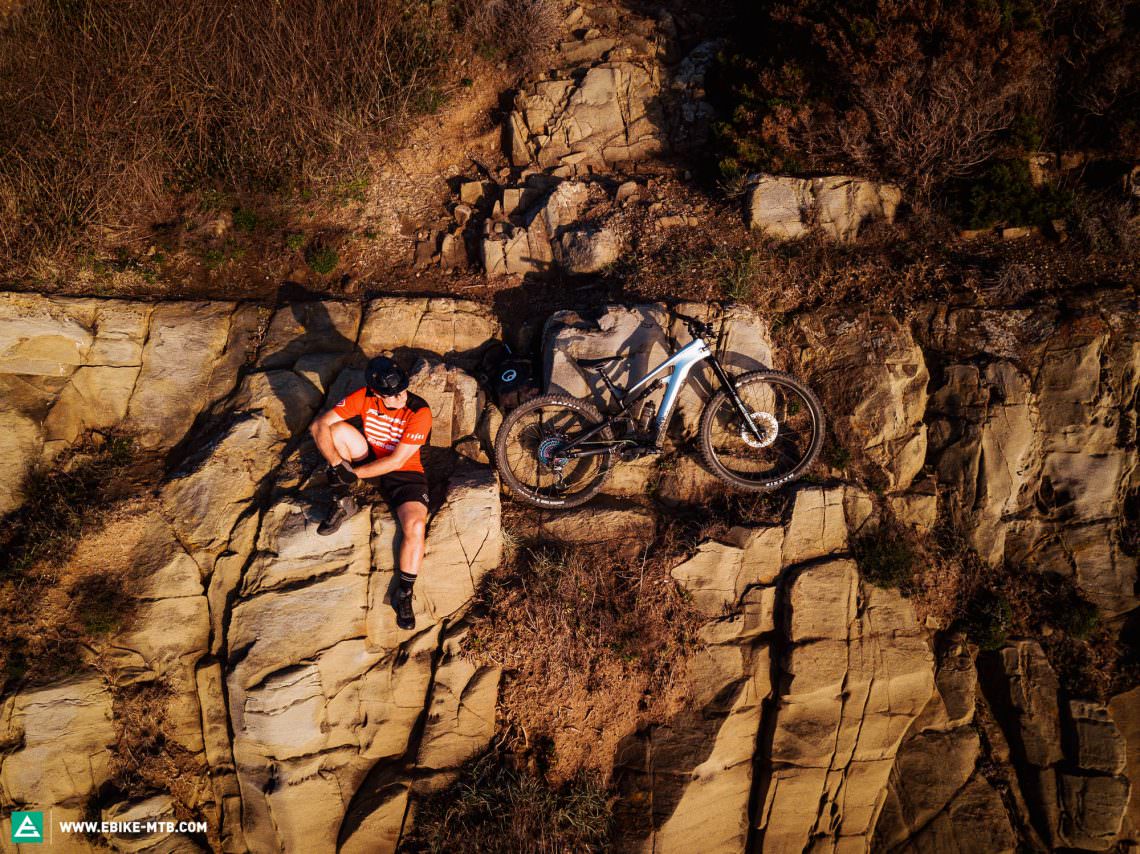
Jersey Fasthouse Fastline Slash | Shorts Fox Ranger Shorts
Shoes Five Ten Trailcross Mid Pro | Gloves Roeckl MALIX
A unique feature of the Cannondale Moterra is its different wheel sizes. In size S, the Moterra rolls on 27.5″ wheels to give smaller riders (from 1.57 m tall) more freedom of movement. All other sizes are specced with big 29” wheels. On top of that, the suspension kinematics are adjusted to suit the various frame and respective rider sizes. Compared to the rest of the test field, the geometry of the new Moterra is rather conservative, except for the seat angle, which at 75° is noticeably slacker both on paper and the trail, and slackening out further as you extend the dropper post. However, this plays into the Moterra’s favour on long rides, where the pedalling position is pleasantly comfortable and gentle on the wrists. In combination with the sensitive suspension and relatively chunky tires, the Moterra offers a high level of comfort even on long rides.
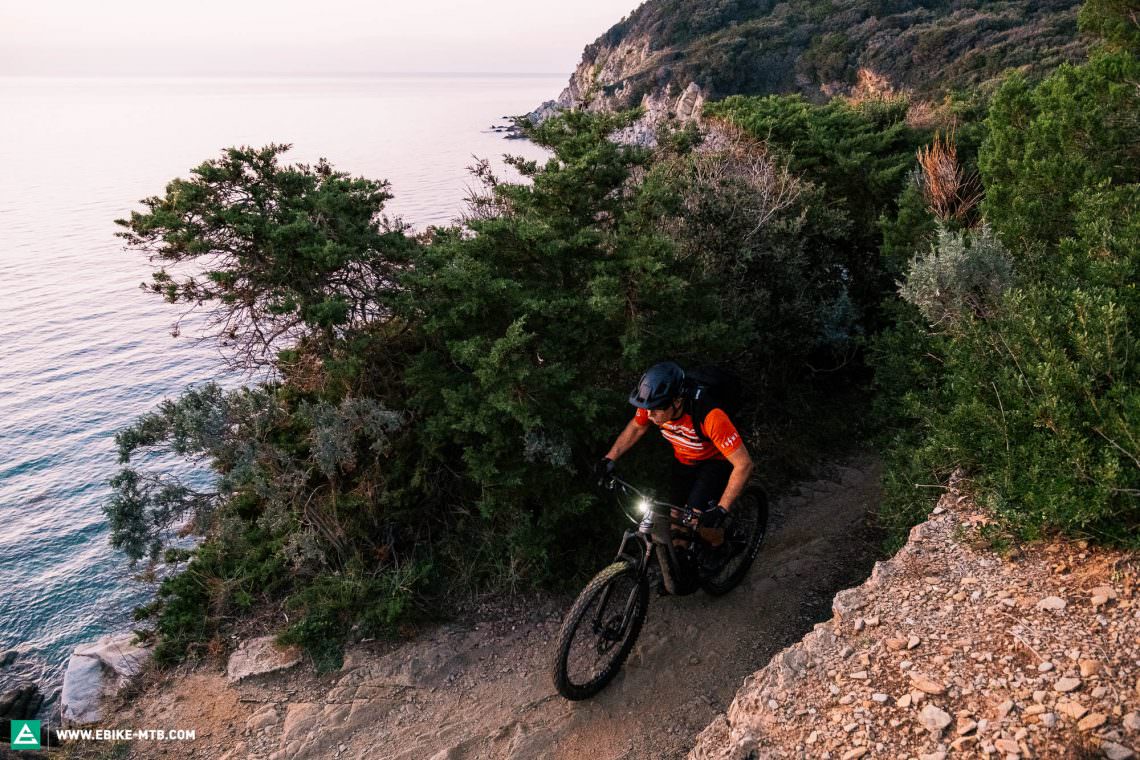
For everything and everyone: The Cannondale Moterra Neo Carbon 1 on the trail
Uphill, the pedalling position of the Moterra is rear-heavy, especially for tall riders. Nonetheless, the bike is good-natured and delivers solid climbing performance. On technical climbs, the high bottom bracket prevents pedal strikes and lets you focus on more important tasks, like getting your weight over the front wheel to prevent it from lifting. Thankfully, you’ll get some help from the rear end of the Moterra, which sits high in its travel yet still maintains lots of traction, efficiently transferring the power of the 85 Nm motor onto the trail, even in the powerful Turbo mode. Uphill, the Moterra Neo Carbon 1 only reaches its limits on very steep climbs and through tight corners.
The Moterra Neo 1 is a great choice for everyone who wants to combine everyday riding, trail adventures, long-distance comfort and good-natured handling. However, on the trail, the bike can’t keep up with the sportiest models in our group test.
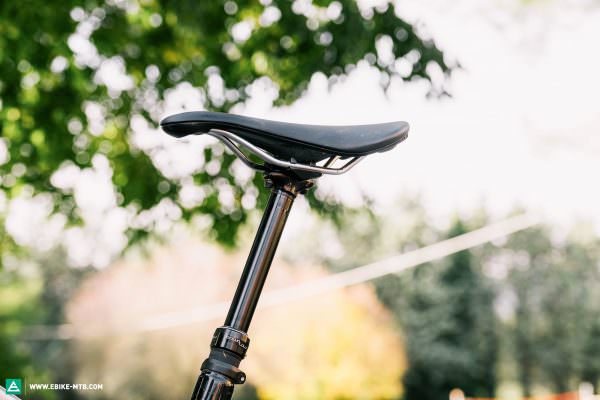

Tuning tip: dropper post with better ergonomics and more travel
Downhill, the Cannondale is a great compromise for all types of riders. The entire test team agrees: whether you’re a leisure rider or ambitious trail surfer, hardly any other bike in the test field inspires this much confidence from the get-go. The handling is smooth, good-natured and predictable, not least thanks to the balanced weight distribution. In combination with the plush suspension, this ensures excellent traction even in loose corners and during hard braking on steep terrain. Faced with nasty impacts and fast (or heavy) riders, the suspension struggles to provide enough reserves and support, preventing you from stepping on the gas on long stretches and playing with the trail features. Even on winding trails, the relatively heavy Moterra requires a good dose of physical effort but, in return, offers a comfortable and confidence-inspiring ride even for newbies and hobby riders with poor technique.
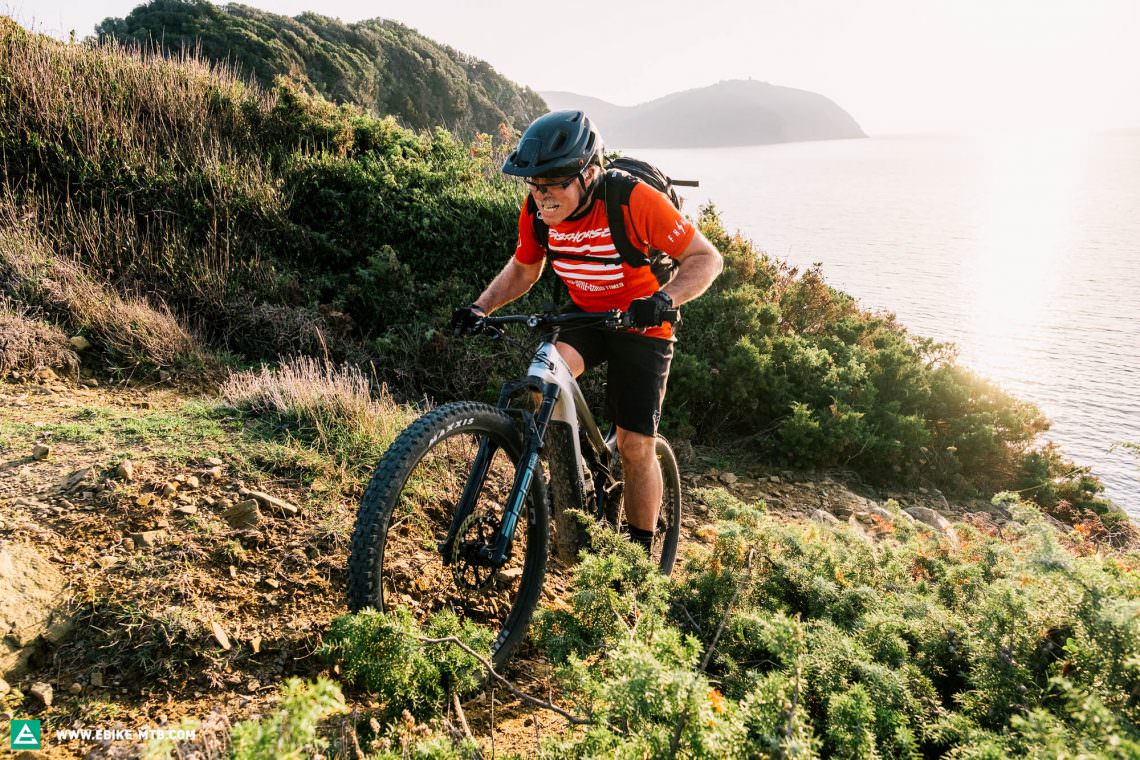
Riding Characteristics
7Agility
- sluggish
- playful
Stability
- nervous
- stable
Handling
- demanding
- balanced
Riding fun
- boring
- lively
Motor feeling
- digital
- natural
Motor power
- weak
- strong
Value for money
- poor
- top
Conclusion
With its intuitive and good-natured handling, the Cannondale Moterra Neo Carbon 1 appeals to a wide range of riders – everyone from touring freaks to ambitious trail surfers. While it struggles to keep up with the sportiest bikes on the trail, the comfortable riding position and everyday features like the Supernova lamp make it an excellent all-rounder and a great option for long rides.
Tops
- very versatile
- easy, good-natured handling
- high level of comfort
Flops
- technical climbs
- sluggish in tight corners
- untidy cable management

You can find out more about at cannondale.com
The test field
For an overview of the test fleet head to the group test: The best eMTB of 2021 – 25 models in review
All bikes in test: Cannondale Moterra Neo Carbon 1 | Canyon Spectral:ON CF 9 (Click for review) | CENTURION No Pogo F3600i (Click for review) | CUBE Stereo Hybrid 140 HPC SLT Nyon (Click for review) | CUBE Stereo Hybrid 160 C:62 SLT Kiox (Click for review) | Ducati TK-01 RR (Click for review) | FLYER Uproc6 9.50 (Click for review) | FOCUS JAM² 6.9 NINE (Click for review) | GIANT Trance X E+ 1 (Click for review) | Haibike AllMtn 7 (Click for review) | KTM Macina Kapoho Prestige (Click for review) | Lapierre Overvolt GLP 2 Team (Click for review) | MERIDA eONE-SIXTY 10K (Click for review) | Mondraker Crafty Carbon XR (Click for review) | Moustache Samedi 29 Trail 8 (Click for review) | ROTWILD R.X375 ULTRA (Click for review) | Santa Cruz Bullit X01 RSV Air (Click for review) | SCOTT Ransom eRIDE 910 (Click for review) | SIMPLON Rapcon PMAX (Click for review) | Specialized S-Works Turbo Levo (Click for review) | Specialized S-Works Turbo Levo SL (Click for review) | STEVENS E-Inception AM 9.7 GTF (Click for review) | Thömus Lightrider E2 Pro (Click for review) | Trek Rail 9.9 X01 (Click for review) | Whyte E-150 RS 29ER V1 (Click for review)
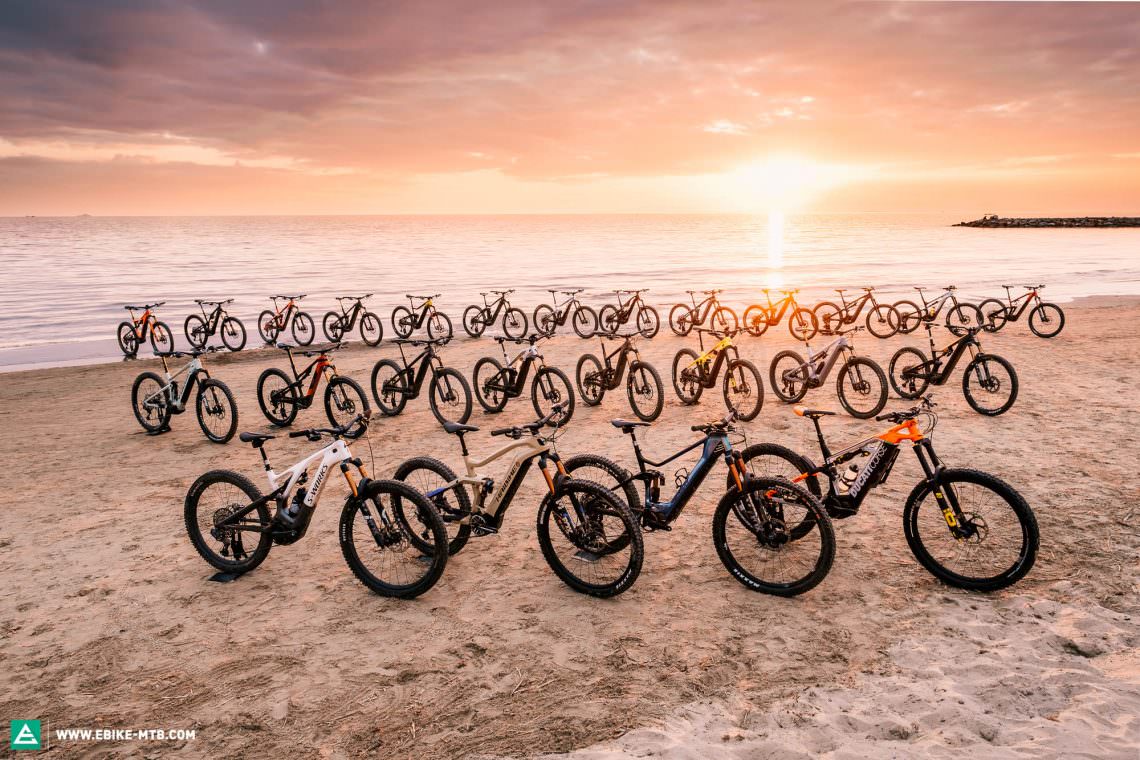
Relaxed and comfortable riding on surfaced roads, both uphill and downhill.↩
Easy climbs up trails with few obstacles, wide turns and a moderate incline.↩
Active and playful descents on easy trails with few obstacles, wide turns and a moderate slope.↩
Single-track climbs on challenging terrain. Loose ground, steps, roots, tight corners and occasionally extreme inclines.↩
Singletrack descents on challenging terrain. Loose ground, steps, roots, tight corners and small jumps as well as some very steep descents.↩
High speed descents on sometimes very rough trails with large jumps and obstacles that you can’t roll over.↩
The rating used for riding characteristics refers to the bikes in the group test and the current state of development of eMTBs. The best bikes managed to blend supposedly opposite riding characteristics, feeling both lively and stable at the same time. The handling describes the balance of the bike on downhill sections. The information regarding motor-power refers to the ride-feeling in the overall context of the bike and not exclusively to the motor – that’s why the same motor can present different values.↩
Did you enjoy this article? If so, we would be stoked if you decide to support us with a monthly contribution. By becoming a supporter of E-MOUNTAINBIKE, you will help secure a sustainable future for high-quality cycling journalism. Click here to learn more.
Words: Photos: Various









